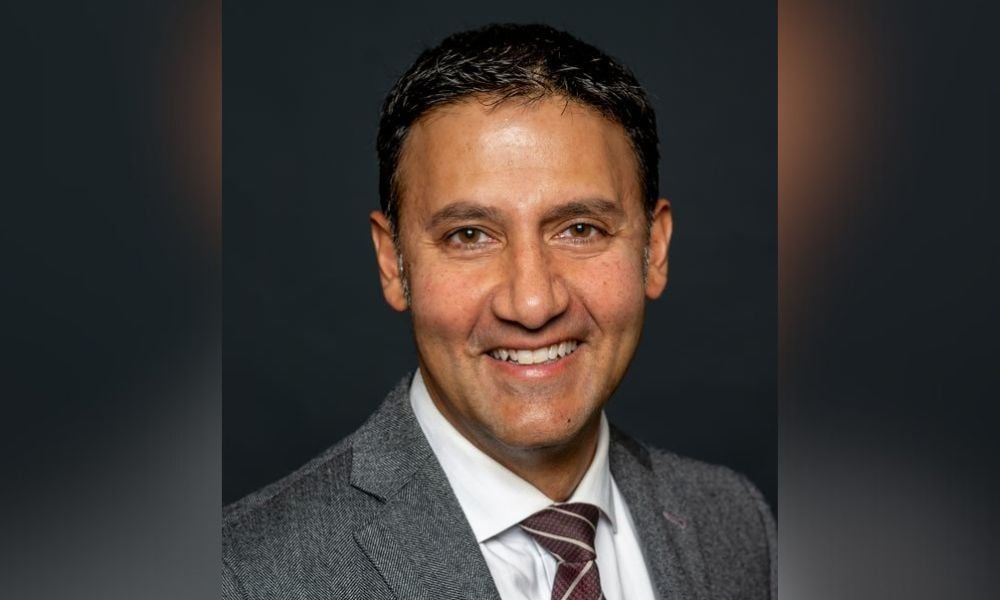While alternative fee arrangements and seeking out external law firms with a diverse roster of lawyers were not top of mind for most in-house counsel who participated in Canadian Lawyer’s 2018 Corporate Counsel Survey, the billable-hour model and developing external counsel relationships were.

While alternative fee arrangements and seeking out external law firms with a diverse roster of lawyers were not top of mind for most in-house counsel who participated in Canadian Lawyer’s 2018 Corporate Counsel Survey, the billable-hour model and developing external counsel relationships were. And although the survey indicated legal departments kept their workweeks moderate, others say 60-hour workweeks go with the territory.
Click here for a PDF of the the full results as they appear in print in our November/December 2018 issue.
Once again, risk management is the top issue facing legal departments in 2018, presenting a pressing issue but also an opportunity, says Tony Linardi, general counsel and corporate secretary at Golder Associates Ltd., a global engineering firm with clients in oil and gas, mining, power, infrastructure and manufacturing.
Corporations want all their departments to add to the bottom line, and risk management is a chance for the legal team to add value to the company, Linardi says. “Over time, where the company’s either losing money or not being as profitable as they can because of risk issues, that’s one thing that the legal team can actually come in and show value and add real value,” he says.
“At the end of the day, the company wants every department to contribute to its bottom line.”
Compliance was a close second for respondents. With Golder’s competitors in the mining industry facing steep fines and some executives jailed for fraud and corruption, Linardi says the company is hyper-conscious and vigilant about compliance.
“From our perspective, in the engineering and construction industry, compliance has become huge,” he says. “More and more, the C-suite wants to make sure that the company’s being compliant in all regards, whether it’s domestic applications or foreign applications.”
Gary Goodwin, executive corporate secretary and counsel at Ducks Unlimited Canada, says that, depending on the risk profile of the client, the risk may be something to embrace. In-house counsel don’t want anything to happen on their watch, but it is also their job to help facilitate transactions, he says.
“I think lawyers are too focused on trying to get rid of the risk when it’s really determined by the risk profile of the client itself as to whether or not it’s a risk they can, certainly, take on,” he says.
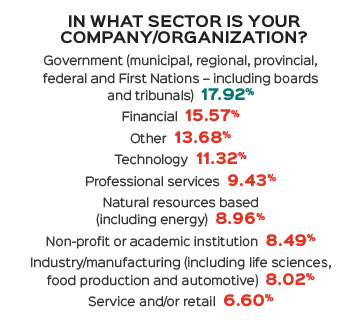
Managing risk also requires the legal department be engaged with the rest of the company because legal is the quarterback for risk management, whether it happens in human resources, finance or it involves an insurance provider, bank or the media, says Linardi.
“So, it’s pretty important to make sure that there’s someone that [gets] involved quickly and knows how the company handles risk,” he says.
Counter to risk management’s perennial dominance in the survey, for four years, seeking out diverse law firms has not been a prevalent practice among in-house legal departments. Of the 212 respondents in 2018, just 11.9 per cent said they were in the habit of asking for a diverse roster of lawyers to work with, much like in 2015 and 2016, and following a high of 21 per cent in 2017. Seventy-one per cent said they do not make this ask.
Respondents left comments indicating why this number has not taken off, even with diversity’s increasing relevance in the legal profession.
“We focus on skill and expertise. Diversity is irrelevant,” said one commenter. Another said it was “a means for employers to satisfy human rights law obligations,” but not a “legal obligation” or “business advantage.”
Another said it was an issue promoted among smaller boutiques but not the national firms they used.
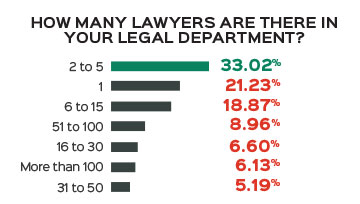
For those who do seek out a diverse roster, the fact that it’s not easy to find partners and practice group leaders who fit the bill can be problematic, says Harpreet K. Sidhu.
Sidhu, who is general counsel and privacy officer at Pethealth Inc., says that when she searches for industry-specific lawyers, there seems to be a lack of diversity among senior partners. “If there were more diverse partners, then there would be more visibility online and more visibility in the legal community,” she says. “And I think that would trigger going to those people as well and trigger some more diversification. But I think there is a lack of that right now.”
In line with most respondents, Sidhu chooses the external firms she works with based on industry expertise. According to the survey, it is individual lawyers and not their firms that attract business from legal departments.
While 66 per cent said they choose based on industry expertise and 62 per cent base their choice on specific lawyers, only 33 per cent said law firm reputation would seal the deal, second to last in front of the four per cent that rely on third-party legal rankings/recognition for a reference.
“My practice is usually ‘follow your expert,’” Sidhu says. The reason is twofold: They have a relationship and those lawyers know her industry.
“I’ve had lawyers that have now changed firms and, honestly, because they know our industry, and we’re a unique industry . . . we usually follow the lawyer wherever they go,” she says.
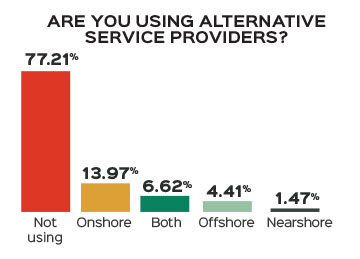
“It’s all about relationship building nowadays,” Sidhu says. “That’s why a lot of lawyers who are leaving big firms and opening up their own practices have clients because their clients are following them into their practice as well.”
For Ducks Unlimited, which operates mostly in rural areas, Goodwin seeks out the help of local, small-town firms. He says diversity is relevant, but it is not a buyer’s market when seeking close-proximity legal advice in, for example, northern Manitoba. “They only have so many options.”
For the fourth year in a row, litigation is the most commonly outsourced work among legal departments, with 75 per cent saying it was the practice area they sent to outside firms the most. Employment and labour came in second at 55 per cent.
Cost and transparency are key to building legal-department-to-outside-firm relationships. For four straight years, the most important thing firms can do to improve the working relationship with the company was being more concerned about costs.
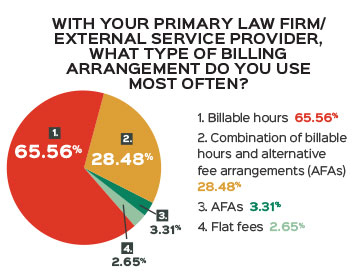
For Sidhu, the legal department and outside firm need to be on the same page about requirements, priorities and expectations for the file to keep costs in line. Without that communication, a legal department budget can be drained of hundreds of thousands in unanticipated costs, something Sidhu experienced on a recent deal, when she was working with one lawyer and didn’t realize there were 10 lawyers working on the back end of the file.
“I think it’s absolutely crucial to let your external firm know exactly where your expectations are,” she says.
Put on paper what the junior associates can do, what needs a senior partner, what is urgent and how many lawyers you want working on the file, says Sidhu.
That communication needs to be directed within the company as well, so legal can engage externally, effectively and efficiently. Sidhu says she consults with her CEO on what aspects of the file need to be handled by a senior partner and which are less significant from the business standpoint.
“I think that helps a lot with the value-based billing and making sure that you get exactly what you need without breaking your budget,” she says.
Linardi says knowing your external firms well is key to keeping costs down. “I think an often-under-looked avenue for cost containment is relationship building,” he says. “I think just having a good relationship with counsel where expectations are clear and you have a lot of trust in that relationship.”
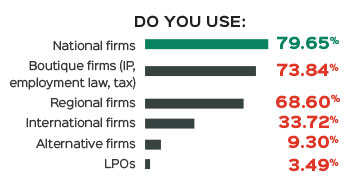
And when you’ve reached an agreement but unpredicted complications arise in the process, “there is nothing that can’t be negotiated,” Sidhu says.
The process is underscored by the 67 per cent of respondents who said general counsel/legal department had the autonomy to select firms.
In an encouraging improvement, outside law firms are becoming more proactive and personal in their dealings with corporate legal departments, says Sidhu. Like a friend, the relationship prospers when one side isn’t just calling when they need something. Keeping an ear to the street and offering tips or help when external counsel’s life intersects with the industry in which Sidhu is enmeshed all day every day strengthens the working bonds, she says.
“It just goes to show that there’s a relationship and there is somebody that is looking out for you,” she says. “We can’t see everything and it’s nice when you know that one of your external partners is watching over for you to make sure you don’t miss anything.”
Unlike risk management, alternative fee arrangements are not dominating the in-house bar. Sixty-five per cent of survey respondents said they are using a billable-hour model with their external legal providers and only three per cent are using AFAs. Of those who do use AFAs, 60 per cent use them only for up to 25 per cent of the work they send out.
There may be more action on the AFA front if law firms were suggesting them to legal departments, but only seven per cent of respondents said their firm introduced the idea of using them.
“I would say there’s still a lack of consistency in the industry. It’s very rare that the law firm will ask us for an AFA,” says Linardi. “Usually, it’s Golder that would have to bring the issue up and, once we do that, they’re pretty responsive to try to structure something that would work.”
Linardi says he’s using AFAs more frequently and has found success with them with their real estate services provider.
“We’re able to measure our legal spend a lot more efficiently, and that helps the company plan a lot more efficiently for real estate costs in general,” he says.
But as to the value of AFAs, some of the survey participants left comments in sharp contrast to Linardi’s real estate experience.
“AFAs are generally an expensive gimmick,” said one. In the spirit of the divide between the 50 per cent of respondents who saw no added value in AFAs and the 44 per cent who said they did, one commenter left the note that the “jury is still out on value of AFAs.”
Developing AFAs takes time, which has a cost, so many firms and legal departments stick to what they know, Linardi says.
But to make AFAs work takes consistency and learning from mistakes when they don’t work, he says. “You have to have a client and a law firm that are both creative and that want the AFA to work. If the first time we tried an AFA it wasn’t that successful, you have to learn from that, but you have to try again,” he says.
“So, it takes some planning and it takes some effort.”
The biggest issue facing legal departments for 10 per cent of the survey participants was scope creep — the unloading of non-legal work on the legal department. But like the issue of risk management, with scope creep, Linardi sees an opportunity.
It’s a “double-edged sword,” he says. While it increases the legal department’s workload, it gives legal a better perspective on new developments and challenges the company is experiencing. Though scope creep happens increasingly, he says, he wants the other divisions to come to him with problems, and many problems without a legal element can develop one quickly if not handled promptly and properly.
Goodwin says he prefers the term “chipping in” over “scope creep” and wants to be involved on the “business side of things.”
“Doing things that are sort of quasi-business, quasi-legal and, if [lawyers] have certain skills and talents, you should use those skills and talents for stuff that’s not strictly law or legal-oriented and use them toward using your creative thinking, intuitive skills on other parts of the business,” he says. “So, that’s good.”
Even with scope creep, legal departments claim to be keeping the hours down to levels conducive to work-life balance. Forty per cent said they worked between 35 and 45 hours per week and another 36 per cent said they worked between 45 and 50 hours. Only five per cent said they clocked more than 56 hours.
Linardi says those numbers seem low, his being in the 60-hours-a-week range.
“But, you know, it comes with the territory. I think that a lot of people think that when you’re in a leadership role, you delegate more things,” he says. “But it’s more of a service role from my perspective, and you’re just helping, you’re supporting more people and that takes time, because there’s your regular job to do and you also have to support people.”
But the reasonable workweek reflected in the survey is not a surprise to Sidhu, who says 35 to 45 hours a week is “bang on,” but she notes that it can fluctuate depending on what is going on. Sidhu oversees operations in four different time zones and some days she works overtime, while other days it balances out.





